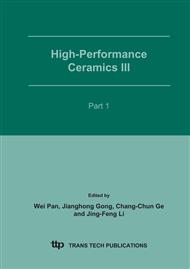p.919
p.925
p.929
p.935
p.941
p.947
p.953
p.957
p.963
Dependence of Dielectric Behaviour of Magnesium Aluminum Silicate Glass-Ceramics on Alumina Content
Abstract:
Magnesium aluminum silicate glass-ceramics were prepared by controlled heat treatment of base glass. The Al2O3 content was varied from 7.58 to 14.71mol % keeping total Mg content almost constant in the form of (MgO+MgF2). The crystalline phases were identified by X-ray diffraction technique while scanning electron microscopy was employed for finding the microstructure in the sample. The dielectric behaviour of the material was studied over the frequency range from 10-107 Hz and in the temperature range from 603 to 793K using impedance analyzer. X- ray diffraction studies revealed the formation of pure and mixed phases of MgSiO3, fluorophlogopite and Mg2SiO4 depending upon the alumina content. Mixed phase material has higher dielectric constant (e′), loss factor (e²) and dissipation factor (tand) than the single-phase material at lower frequencies. Dielectric constant (e′) decreases with frequency rather sharply up to 104Hz, and then remains nearly constant at higher frequencies up to 107Hz. However, tand first increases and then decreases with frequency passing through a broad peak. In all the cases e¢ and tan d are seen to increase with temperature. The activation energies for dipolar relaxation were calculated for all samples and were found to vary from1.77Joule/mole to 13.82Joule/mole with variation of alumina from 7.58 to 14.71mol %.
Info:
Periodical:
Pages:
941-946
Citation:
Online since:
February 2007
Authors:
Price:
Сopyright:
© 2005 Trans Tech Publications Ltd. All Rights Reserved
Share:
Citation:


